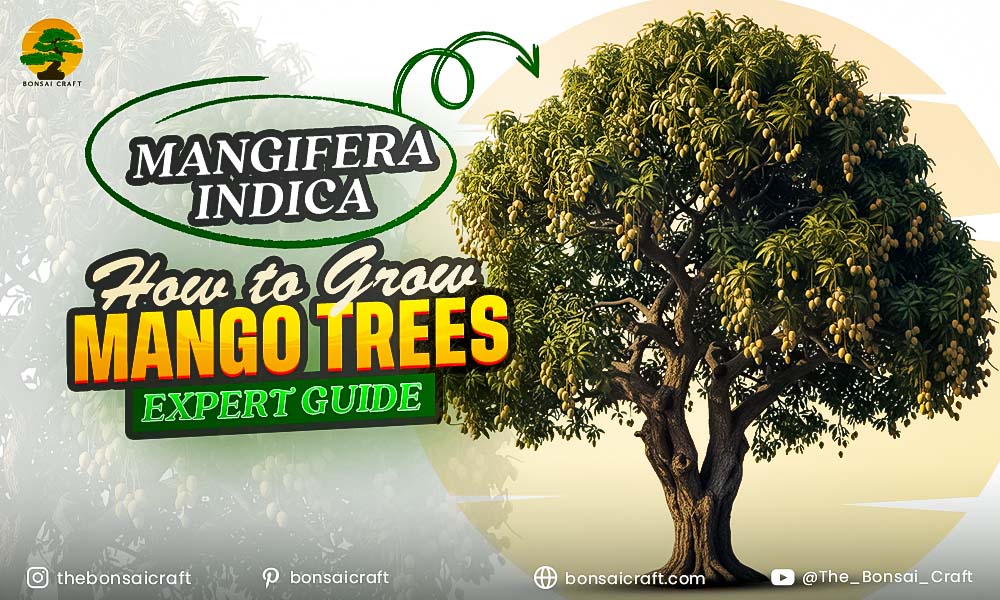
When you plant a Mangifera indica (commonly known as the mango tree), you’re choosing one of the most iconic tropical fruit trees in the world. This guide will walk you through how to grow mango trees—from site selection to watering, fertilizing, flowering, and harvesting—with clear, actionable advice based on expert insight and scientific facts. You’ll learn how to care for the mango plant, understand the mango flower and fruit development, and even how to pronounce “Mangifera indica” properly (man-gi-FER-uh in-DIE-kuh).
What is Mangifera indica?
Mangifera indica is a species of large, evergreen fruit tree in the cashew family (Anacardiaceae) grown for its edible mango fruit.
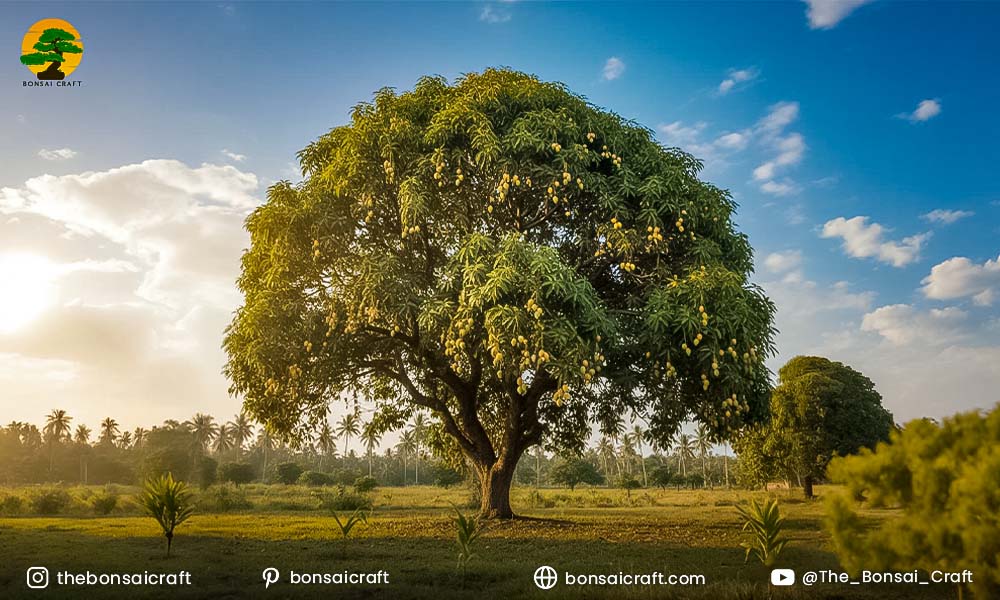
Mangifera indica, commonly known as the mango tree, is a tropical evergreen prized for its sweet fruits and cultural importance.
Key Facts & Expert Insight
- The tree is native to South Asia (north-western Myanmar, Bangladesh, northeastern India) and has been cultivated for thousands of years.
- It can grow to heights of 10–45 m (33-150 ft) in ideal conditions, with a broad canopy.
- The fruit is a fleshy drupe, with hundreds to thousands of cultivars worldwide.
- The botanical name: Mangifera (genus) + indica (species) → literally “mango-bearing from India”.
Pronunciation
how to pronounce Mangifera indica → “man-gi-FER-uh in-DIE-kuh”
Why this matters for growers
Understanding what Mangifera indica is helps you respect its size, climate needs, and long-term potential. If you treat it like a shrub, you’ll be disappointed. It’s a tree that demands space, sun and warmth.
Selecting the Right Site & Climate for Mango Trees
Choose a warm, frost-free site with full sun exposure and well-draining soil; Mangifera indica thrives in tropical to subtropical climates.
Climate Requirements
- Mango trees tolerate temperatures from about 10 °C upward but cold below ~0 °C is damaging.
- Full sun is essential—aim for at least 6–8 hours of direct sunlight daily.
- Humidity and airflow matter: in humid areas, good air circulation helps prevent pests and disease.
Soil & Site Conditions
|
Factor |
Ideal Conditions |
| Soil Drainage | Sandy-loam, well-drained (Mangifera indica dislikes water-logged soils). |
| Soil pH | Mildly acidic to neutral (≈ 5.5-7.5) |
| Space | Allow mature tree 8-10 m width or more |
| Protection | Shelter from strong winds, frost or cold snaps |
Expert Tip
An orchardist in Florida reported that even when planted in rich soil, his mango tree failed to fruit the first 2 years because it received only partial sun (≈4 hours). After relocating to full-sun site, the tree flowered in year three.
How to Plant Mangifera indica (Mango Tree)
Plant a healthy young mango tree or seedling in spring, ensuring a deep planting hole, light soil amendment, and careful watering until established.
Step-by-Step Planting
- Dig a hole twice the width of root ball, same depth.
- Loosen roots gently; place the tree so root crown is level with ground.
- Backfill with native soil mixed 1:1 with organic compost or well‐rotted manure.
- Water thoroughly to settle soil and eliminate air pockets.
- Apply 5–10 cm mulch around base, leaving trunk clear.
Spacing & Depth
- Plant at least 6–8 m away from buildings or other trees to allow for canopy spread.
- Plant slightly higher than ground level if soil risk is poor drainage.
Timing
- Plant after last frost and once soil is warm.
- In tropical zones, early rainy season is ideal.
Expert Insight
Root system of Mangifera indica develops a deep tap-root (up to 5 m) and wide lateral roots. Therefore, avoid placing it near foundations or narrow strips.
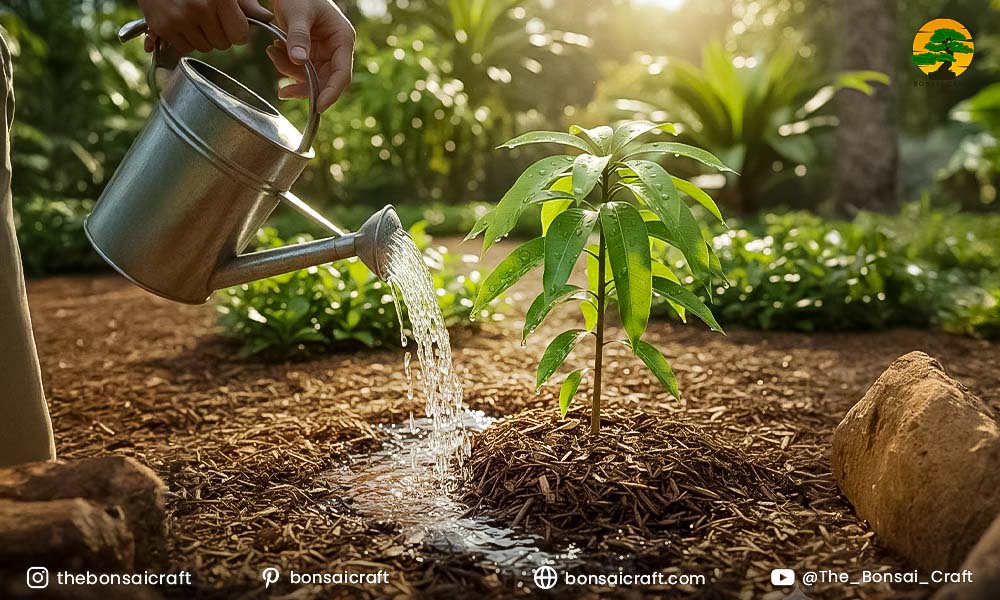
Mango trees need deep but infrequent watering to strengthen roots and prevent fungal diseases.
Watering & Irrigation Guidance
Water young mango trees frequently to establish roots; once mature, Mangifera indica needs moderate watering, allowing soil to dry somewhat between irrigations.
Watering Schedule
- Year 1–2 (establishment): Water twice weekly (more if sandy soil or drought).
- Mature trees: Irrigate deeply once every 10–14 days, adjusting for rainfall and soil type.
- Reduce watering during cooler/dormant seasons.
Signs of Water Stress
- Wilting or drooping leaves → underwatering
- Yellowing leaves, root rot or poor growth → overwatering/lack of drainage
Practical Tip
During dry spells, apply drip irrigation or deep soak from sprinkler; avoid light frequent watering which encourages shallow roots.
Expert Insight
According to University of Florida’s IFAS publication, a healthy mango tree produces “white, yellow, pinkish or reddish flower spikes in early spring” once stress is reduced and the root system is established.
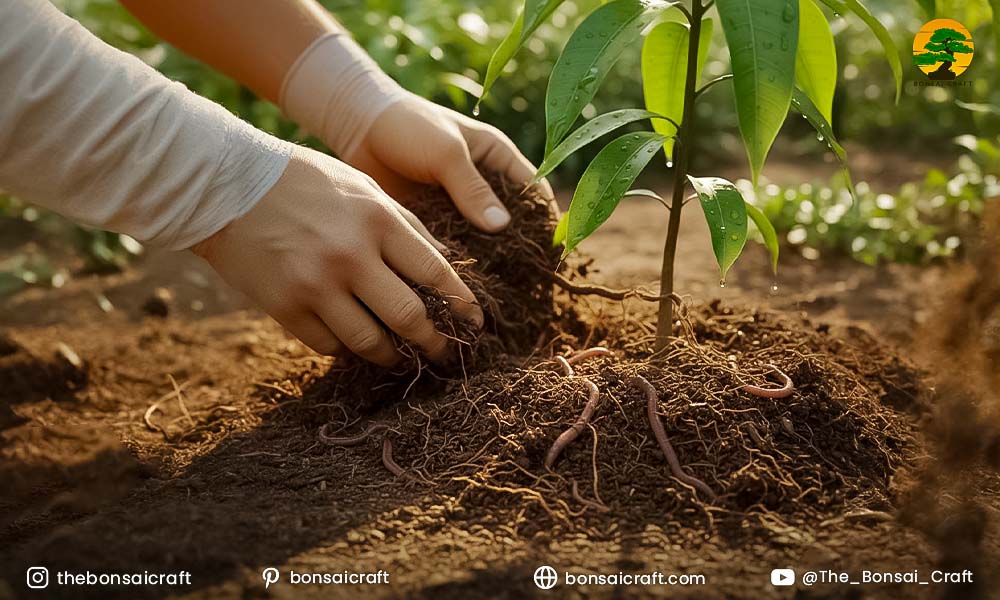
Rich, well-drained soil with organic compost boosts Mangifera indica growth and enhances fruit yield.
Soil Fertility & Fertilising
Fertilise Mangifera indica with balanced nutrients in early growth, then shift to higher potassium when fruit develops.
Fertiliser Recommendations
|
Stage |
Nutrient Ratio |
Notes |
| Young tree (yr 1-3) | N-P-K 10-10-10 or similar | Encourage root and foliage growth |
| Pre-flowering | N-P-K 8-4-8 | Reduce nitrogen to push bloom |
| Fruit set & growth | N-P-K 6-4-10 or K-rich | Potassium supports fruit quality |
Timing & Application
- Apply 3-4 times per year for young trees; 2-3 times for mature trees.
- Apply after rainfall or irrigate immediately.
- Supplement with micronutrients (zinc, boron) if blooms are poor.
Expert Insight & Fact
Leaves of Mangifera indica are rich in antioxidants (mangiferin, flavonoids) and uptake is supported by good soil nutrition.
Flowering, Pollination & Fruit Set
Mangifera indica produces large panicles of small fragrant flowers in late winter to early spring; only a small fraction develop into fruit.
Flowering & Pollination Facts
- The flower panicles contain male and bisexual flowers; they are typically 10-40 cm long.
- Pollination is mainly by insects; poor pollination or environmental stress reduces fruit set.
- Typically less than 1% of flowers may set fruit.
Fruit Development
- After pollination the mango fruit grows for several months (varies by cultivar).
- Mature fruit size, shape and colour depend on cultivar (some up to 2.3 kg).
Tip to Encourage Fruit
- Ensure tree is mature (3–5 years or grafted variety).
- Stress the tree slightly (reduce water) at bloom time to induce flower set.
- Remove excess fruitlets to improve size and quality.
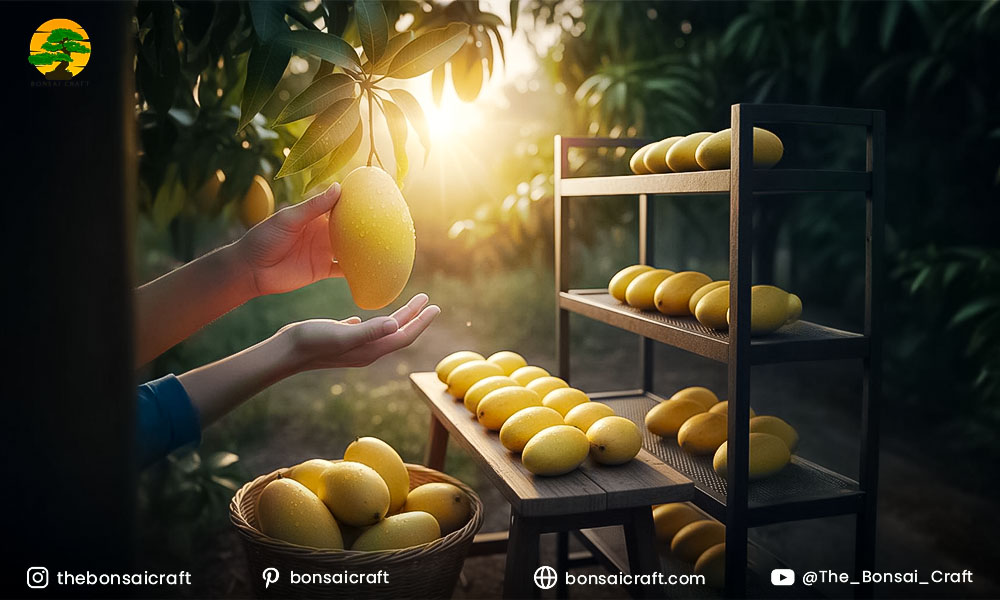
Harvest mangoes when they turn golden-yellow and store them in a cool, dry place for natural ripening.
How to Harvest & Store Mango Fruit
Harvest mangoes when they develop full colour and slight softness; store at ~13 °C to prolong shelf life.
Harvesting Indicators
- Skin colour changes depending on cultivar; for example from green to yellow or red blush.
- Slight softness adds to flavour.
- Aroma near stem.
Storage Guidelines
- Harvested fruit can be stored for a short period (1–2 weeks) in cool conditions (~13–15 °C).
- Do not refrigerate below 10 °C long term; chilling injury may occur.
Expert Fact
Global mango production (including Mangifera indica) was about 55.4 million tonnes in 2018.
Value for Home Grower
Your own harvest may be small, but flavour will typically surpass store-bought variety due to freshness and full ripening on tree.
Recommended Varieties & Cultivars
Choose cultivars adapted to your climate and space — many grafted Mangifera indica varieties are suited to smaller gardens or container growing.
Examples of Varieties
- ‘Himsagar’ (India/Bangladesh) — good flavour, fibre-free pulp. Wikipedia
- ‘Totapuri’ (India) — distinctive shape and mild flavour.
Selection Criteria
- Cold tolerance if your region has cooler weather.
- Dwarf or semi-dwarf types for container or small garden.
- Self-fruiting vs pollinator-dependent types.
Expert Insight
Many commercial mango orchards graft elite cultivars onto rootstocks of Mangifera indica for consistency in fruit quality and earlier bearing.
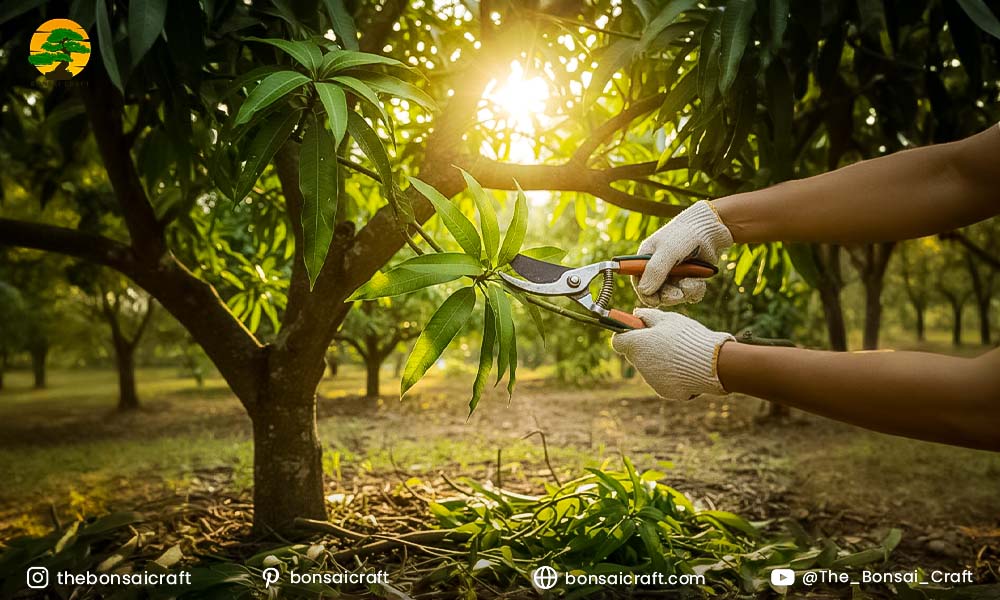
Regular pruning keeps mango trees healthy, improves air circulation, and encourages better fruiting.
Pruning & Tree Maintenance
Prune Mangifera indica lightly to maintain manageable size, improve light penetration, and remove dead or diseased wood.
Pruning Guidelines
- Perform major shaping after harvest or in early spring before new flush.
- Remove crossing branches, thin the canopy to allow air and light inside.
- On grafted trees, avoid cutting below graft union (unless selecting rootstock).
- For container-grown trees, maintain height at ~2-3 m by cutting above a lateral branch.
Expert Insight
Because mango trees can develop large canopies, leaving the tree unpruned may lead to limb breakage under fruit load or shade-induced disease. A Florida University research note: “flower panicles extend well beyond long shiny leaves” so ensure space for blooms.
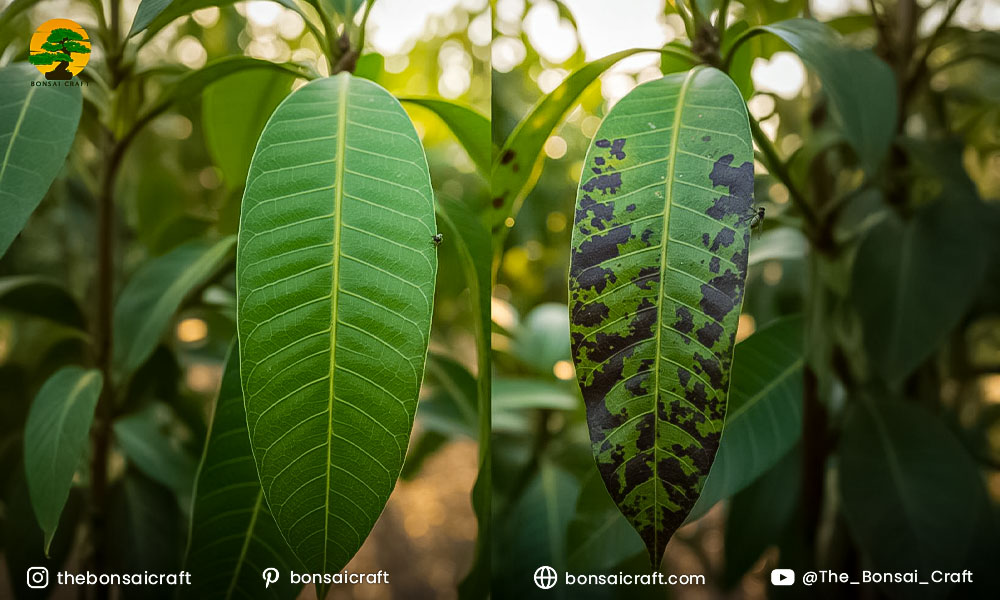
Monitor for pests like aphids and diseases such as powdery mildew to keep your mango trees healthy.
Common Pests, Diseases & Problems
Mangifera indica is susceptible to anthracnose, powdery mildew, scale insects and fruit flies; good cultural practices reduce risk.
Issues & Solutions
|
Problem |
Cause |
Management |
| Anthracnose (black spots on fruit/leaves) | High humidity, poor air flow | Prune for airiness; apply fungicide |
| Powdery mildew | Dry, shaded foliage | Increase sunlight, apply sulphur |
| Fruit flies | Intact fruit skin + warm climate | Bag fruit, use traps, harvest early |
| Scale insects | Sticky sap, neglect | Remove by hand, horticultural oil |
Expert Fact
Some individuals experience contact dermatitis from mango tree sap, fruit skin or wood. Mangifera indica is related to poison ivy/poison oak in the Anacardiaceae family.
Prevention Tips
- Maintain good sanitation: remove fallen debris.
- Monitor regularly for early pest signs.
- Use proper spacing and sunlight to reduce disease pressure.
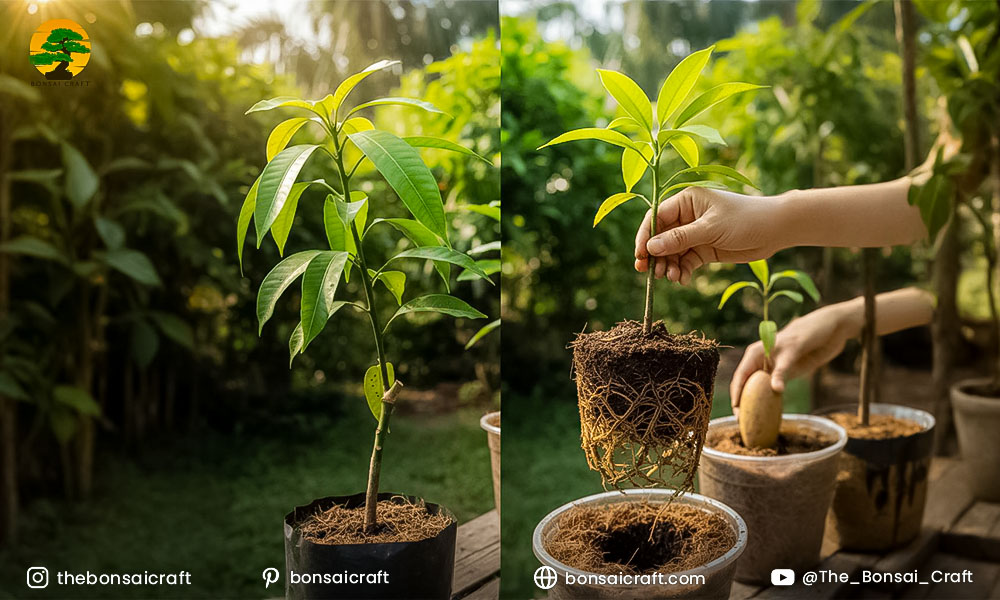
Grafted mango trees fruit faster than seed-grown ones and ensure better quality and consistency.
Growing Mangifera indica from Seed vs Graft
Growing from grafted plants ensures earlier fruiting and true-to-type characteristics; seed propagation may require 5-8 years to bear and results may vary.
Comparison
|
Method |
Time to Fruit |
Advantages |
Disadvantages |
| Grafted | 2-4 years | True type fruit, reliable | Higher cost, less root adaptation |
| Seed | 5-8+ years | Lower cost, interesting genetics | May vary in fruit quality/size |
Practical Steps for Seed Propagation
- Use fresh seed from healthy ripe fruit.
- Plant in well-drained potting mix; keep warm and moist.
- Transplant when seedling reaches ~30-40 cm.
Expert Insight
According to World Flora Online, while several Mangifera species exist, the vast majority of edible mangoes in horticulture are Mangifera indica.
Container Growing & Small Garden Tips
Mangifera indica can be grown in containers if you choose dwarf cultivars, provide full sun and repot regularly; maintenance will differ from ground-planted trees.
Container Guidelines
- Container size: start with 50 L+; anticipate pot size increasing over time.
- Use premium citrus/fruit tree potting mix with good drainage.
- Water more frequently than ground trees; fertilise more often.
- Prune roots and repot every 2-3 years.
Positioning & Care
- Place container in full sun; rotate occasionally for even growth.
- Move indoors (or under cover) if temperatures fall below ~10 °C.
Expert Insight
Because mango roots can extend deep (tap-root up to 5 m), container growth limits size and root depth—so keep expectations proportionate to container-grown tree.
Harvesting & Productive Lifespan
A well-cared-for Mangifera indica tree will begin fruiting in 3–5 years (grafted) and can be productive for 50+ years when planted in optimal conditions.
Facts
- Trees in natural conditions have been known to bear fruit for over 300 years.
- Harvest timing depends on cultivar and region; regularly sample fruit for ripeness.
Productivity Tips
- Yield will improve every year as canopy fills and pollination improves.
- Remove competing vegetation and maintain fertilisation to support production.
Expert Insight
In India, mango trees growing for hundreds of years are still productive — a testament to Mangifera indica’s longevity when cared for correctly.
Pruning Calendar & Seasonal Care
Follow a seasonal care calendar to optimise Mangifera indica’s performance, focusing on bloom, fruit set, and preparation for dormancy or off-season.
Seasonal Tasks
|
Season |
Tasks |
| Late winter | Site inspection, prune dead wood, fertilise |
| Early spring | Monitor for blossom, thin fruitlets |
| Summer | Provide shade if over 35 °C, irrigate deeply |
| Autumn | Harvest fruit, begin reducing fertiliser |
| Winter | Protect young trees from cold, minimal watering |
Expert Insight
Environmental cues like drought followed by irrigation can signal bloom in mango trees; some growers use controlled stress to provoke flowering.
Conclusion
Growing Mangifera indica, the classic mango tree, is a rewarding long-term endeavour. With the right site, full sun, well-drained soil, consistent watering and fertilising, and good pollination practices, you can enjoy lush green foliage and delicious fruit for decades. Whether you plant in the ground or in a large container, apply the expert-backed insights above and you’ll establish a healthy, productive mango tree that honours the heritage and value of this remarkable species.
Frequently Asked Questions (FAQs)
What is Mangifera indica?
Mangifera indica is the scientific name of the mango tree, a tropical fruit-bearing species belonging to the Anacardiaceae family. Native to South Asia, particularly India and Myanmar, it’s one of the most widely cultivated fruit trees worldwide for its delicious, vitamin-rich fruits.
How long does a Mangifera indica tree take to bear fruit?
Typically, a grafted mango tree can start bearing fruits within 3–5 years, while a seed-grown tree may take 7–10 years. Factors such as climate, soil type, sunlight, and pruning practices significantly influence fruiting time and yield quality.
What is the best soil for growing mango (Mangifera indica) trees?
The best soil for Mangifera indica is well-drained, slightly acidic to neutral soil (pH 5.5–7.5). Sandy loam or alluvial soil enriched with organic compost supports the tree’s deep root system and ensures optimal growth. Avoid waterlogged or heavy clay soils.
How much sunlight and water do mango trees need?
Mango trees thrive in full sunlight (at least 6–8 hours daily) and prefer moderate watering. Young trees need regular moisture, but mature mangoes tolerate drought well. Overwatering can cause root rot or fungal diseases such as Anthracnose.
When and how should you prune a Mangifera indica tree?
Prune your mango tree after the harvest season to remove dead, diseased, or crossing branches. Light pruning encourages better air circulation and sun exposure, which helps produce healthier blooms and fruits. Avoid heavy pruning as it may delay fruiting.
